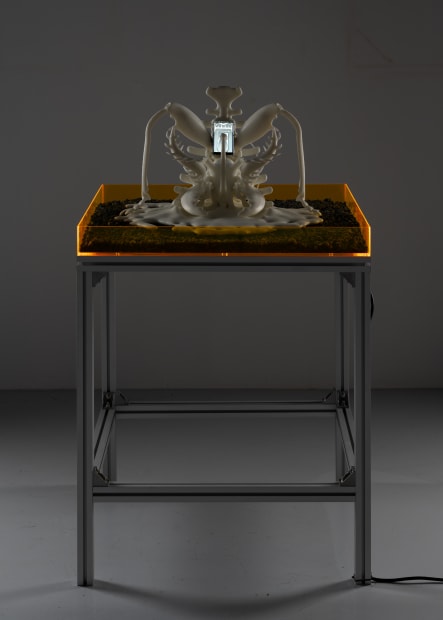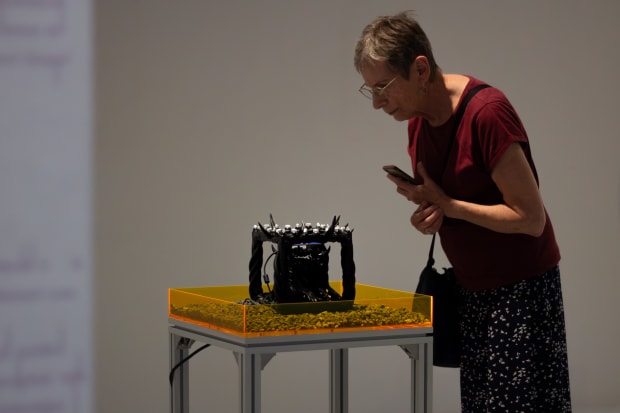-
 Installation View: Brandon Tay, Form and Agency, Yeo Workshop, Singapore (26 August - 1 October). Image Courtesy Jonathan Tan.
Installation View: Brandon Tay, Form and Agency, Yeo Workshop, Singapore (26 August - 1 October). Image Courtesy Jonathan Tan. -
What are some ways that fiction has influenced form in early human history?
Early human history witnessed the profound influence of fiction on various aesthetic forms, shaping art, storytelling, and cultural expression in significant ways. Here are some ways in which fiction has affected aesthetic forms in ancient civilizations:
Oral Traditions and MythologyFictional narratives and myths were passed down orally from generation to generation in many ancient cultures. These myths often featured gods, heroes, and supernatural beings, and they inspired the visual arts, such as pottery, sculpture and paintings. For example, Greek mythology greatly influenced the art and architecture of ancient Greece, with gods and heroes depicted in various artistic forms.Epic PoetryEpic poems like the "Epic of Gilgamesh" in Mesopotamia, the "Iliad" and the "Odyssey" in ancient Greece, and the "Ramayana" and the "Mahabharata" in India conveyed fictional stories of heroism, adventure, and moral dilemmas. These poems were recited or sung and often included vivid descriptions that inspired artistic representations of the narratives.Religious Texts and IconographyMany religious texts such as the Bible, the Quran, and the Vedas, contain fictional parables, allegories and stories that have influenced religious art, including paintings, sculptures, stained glass, and mosaics. These artistic forms were used to illustrate and convey moral and spiritual lessons contained within these texts.Fables and Morality TalesAesop's fables and similar collections of moral stories provided valuable lessons through fictional characters and scenarios. These tales often featured anthropomorphic animals and were depicted in various visual art forms, from ancient Greek vase paintings to medieval manuscripts.Fictionalised Biographies and PortraitureIn ancient Egypt, for example, the practice of creating fictionalised biographies for pharaohs and other elites influenced the depiction of rulers in art. Portraits were idealised to reflect virtues and accomplishments attributed to these individuals.Tribal and Indigenous ArtMany indigenous cultures around the world used fictional narratives, legends, and creation stories as sources of inspiration for their artistic expressions. This includes storytelling through traditional songs, dances, and visual arts, often reflecting the cultural heritage and beliefs of these communities.Ceremonial ArtefactsFictional narratives often played a role in the creation of ceremonial and ritualistic objects. For instance, masks used in tribal rituals often represented mythological or fictional beings, contributing to the rich aesthetics of these cultural practices.In summary, fiction has been a powerful force in shaping aesthetic forms throughout early human history. These fictional narratives, whether rooted in mythology, religious texts, or folklore, served as a wellspring of inspiration for artists, influencing the development of various artistic mediums and expressions. They not only entertained and educated but also enriched the cultural and artistic heritage of societies across the ages.
Brandon had also remarked on how essentially 3D printing is the process of translating and transforming something from a two-dimensional plane into a three-dimensional plane. This he found, was akin to his experimentations for the exhibition, which is on some level the creation of three dimensional objects from four dimensional concepts or vice versa.
The models in the gallery space take on different forms and sizes. Some of them appear slimy and blobby whereas others appear more sharp, rigid and sturdy (albeit still retaining some viscosity at the same time). One would not be faulted for mistaking them as some kind of religious artefact or heavily mutated critters. All of them have been rendered with colours, either monotone or duotone, that somehow feel oddly familiar but alienating at the same time. Brandon had picked these specific colours due to their proximity with colours that we do not and cannot conventionally access, colours that reside internally within our bodies and organs. The artist had arrived at the form differently for each of the models. Some of them he had worked towards with a clear formal idea at the onset, whereas for others, their conceptual reference points had shaped their visual and material forms.




 Brandon Tay, One or Several Agents: Machinic Animism 01, 2023, game-engine live simulation, infinite duration.
Brandon Tay, One or Several Agents: Machinic Animism 01, 2023, game-engine live simulation, infinite duration.The third stack relates to the live and interactive game simulation projected between the first two models at the entrance of the exhibition. The simulation that is beamed onto the gallery walls is a live one, meaning to say that at every moment it is switched on, a new instance is activated and played out. Contained in the simulation is a chrome hued alien environment that looks like either the surface topology of a Mars like planet (its giving vast plains, tectonic erosions, impact craters, terraformations and the likes), or microscopic scenes from a heavily utilised petri dish. Within this environment, the digital spirits of the five models roam freely, moving about to their heart's content with free will and agency. They fly about at times, jitter on the spot, and even crash into or float through each other occasionally. The motivations behind creating such an environment for interaction between them is rooted in Brandon’s curiosity into why there is a general lack of interest in visualising ideas interacting with each other [11] . This is something that is extended even to the way we think about things like our ideological positions. The environment then becomes this testbed for inspecting how multiple ideas can possibly interact. Do they engage in skirmishes and consume each other? Do they create offshoots or mutations? Do they leave traces to some kind of map or pattern of relationality? For me, what is really admirable and commendable about this effort by Brandon is in the fact that it is done under the gumption of an extremely inquisitive and curious mind, and as a form of artistic expression and creative pursuit. A far cry from experimentations happening in some secret lab somewhere else in the world, towards a first mover advantage in AGI future forecasting efforts.
</Form>
View the full microsite here.
[1] Although schismatic, in that doing so presupposes that there is a separation between the two, I am of mind that perhaps there is merit in outlining and delineating the two as respective nodes from which then to draw clearer interconnected lines.
[2] A reference to writer and thinker Benjamin Bratton’s conception of complex megastructures - what he calls “The Stack”, formed via seemingly disparate but correlated components. See: H. Bratton, The Stack: On Software and Sovereignty, (Cambridge Mass: MIT Press, 2016).
[3] Here, Brandon had shared his interest in Deleuze and Guattari’s ideas of ‘becoming animal’. See: G. Deleuze and F. Guattari, A Thousand Plateaus: Capitalism and Schizophrenia, (London: University of Minnesota Press, 1987).
[4] 黑科技 translates to heikeji (black technology), a Chinese buzzword term to describe cutting edge and futuristic technologies. The term originated from the expression ‘black technology’ which first appeared in a Japanese manga, Full Metal Panic!, to describe technologies that do not yet exist. See: Christopher Hobson, “Black Technology”, Imperfect Notes, February 7, 2022, https://imperfectnotes.substack.com/p/black-technology.
[5] The artist had written accompanying notes - in the style of an unreliable narrator - for each of the artworks in the exhibition, that can be found within the exhibition’s microsite. See: https://www.formandagency.net/. A larger wikipedia database had also been created on the occasion of the exhibition, which overlaps with the lore of the exhibition design by designer and artwork collaborator Darius Ou. See: https://form-and-agency.fandom.com/
[6] The term refers to a decorative approach and style in predominantly Western art, furniture, and architecture (especially in the 18th Century) that heavily and intentionally used Chinese visual language, motifs, and techniques.
[7] The Kowloon Walled City was a roughly 2 hectare densely populated informal settlement in Hong Kong in the 1980s that housed close to 50,000 people at its height. See: https://www.atlasobscura.com/articles/kowloon-walled-city
[8] See: https://form-and-agency.fandom.com/wiki/Model_E:_Nomad_Lexis
[9] GANs refer to a machine learning process and framework in which two sets of neural networks compete with each other by using deep learning methods to incrementally become more accurate. See: https://developers.google.com/machine-learning/gan/gan_structure
[10] Pepper’s ghost refers to a relatively old optical illusion technique used in the past in theatre and cinemas. The illusion is performed by reflecting an image of an object to create a holograph.
[11] Perhaps also a similar motivation for the collaboration with Darius for the work Language as Time’s Shadow (...).
Form Follows Fiction: Text by Rafi Abdullah
Past viewing_room











